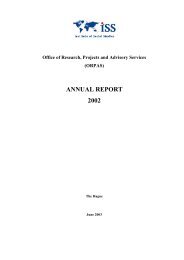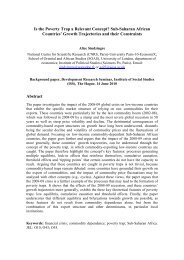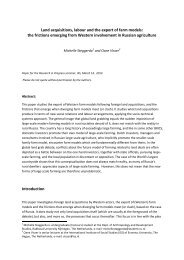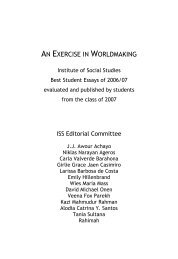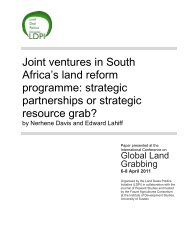AN EXERCISE IN WORLDMAKING 2009 - ISS
AN EXERCISE IN WORLDMAKING 2009 - ISS
AN EXERCISE IN WORLDMAKING 2009 - ISS
Create successful ePaper yourself
Turn your PDF publications into a flip-book with our unique Google optimized e-Paper software.
174 MEL<strong>AN</strong>IE NEWELL<br />
stood, analyzed, and taken into account in SRH programs and their interventions.<br />
The social ecology model developed by psychologist Urie<br />
Bronfennbrenner (1979) is an important analysis tool that can be used to<br />
help develop interventions. The model illustrates the inter-relationship<br />
between social structure, context and agency, and how this relationship<br />
influences behavior and decision-making. According to the model, individuals<br />
make decisions and form behaviors firstly within the context of<br />
their home life (family, peers, school, work, culture) which lies within the<br />
context of a community (job market, media, culture, interventions),<br />
which in turn lies within the wider context of a national and international<br />
system of laws, policies, culture, and institutions (Keysers <strong>2009</strong>b). SRH<br />
attitudes and behaviors need to be analyzed using a tool such as the social<br />
ecology model in order that interventions are designed to reflect the<br />
reality of a complex process of decision-making and behavioral formation.<br />
An ineffective intervention could be one based on statistics that show<br />
a low percentage of male condom use. The intervention promotes female<br />
contraception and also increases male and female access to condoms,<br />
making sure there are adequate resources available. The first problem<br />
with this intervention is that it does not take into account what is<br />
behind the statistics. The reasons why men are not wearing condoms are<br />
not explored, and it is quite possible that they know about condoms, that<br />
they already have access to condoms, but that there are other reasons<br />
condoms are not being used. Introducing women to contraception does<br />
not solve the gendered power relations shaped by a woman’s culture that<br />
might limit her from using contraception. Men must be included in research<br />
in order that their reasons for not using condoms, for example,<br />
are understood and addressed (AGI 2003: 7, Greene 2000: 54). When<br />
research that includes men is done in this fashion, it has been found that<br />
masculine identities and cultural pressures in gender constructs lie at the<br />
heart of the choice to use or not to use a condom, not only availability<br />
(Adriao et. al. 2002: 204). The SRH community has learned to treat<br />
women in their own right, not only as child bearers or wives, however<br />
the same step needs to be taken with men. Including men in research<br />
and designing interventions purposefully to educate and encourage maleinvolvement<br />
in SRH is essential to building a strong foundation for family<br />
life and well-being. Studies that identify the obstacles that prevent<br />
men from being receptive to SRH services and education are few, yet




